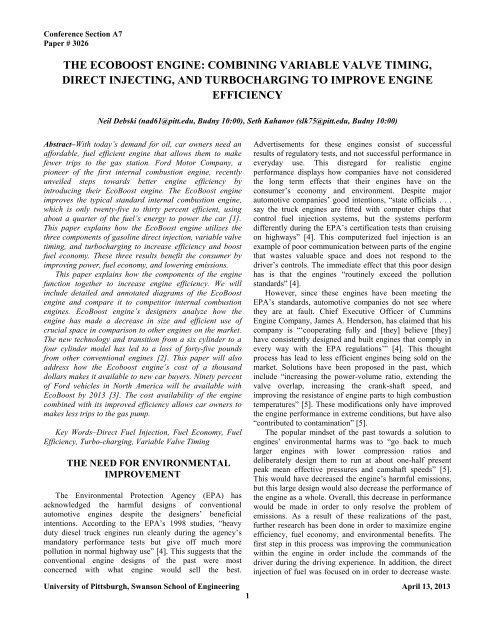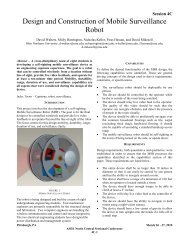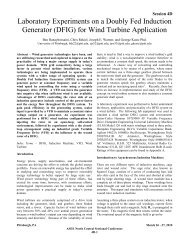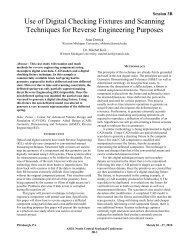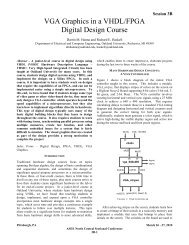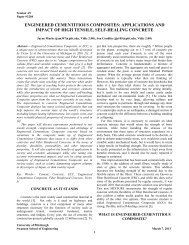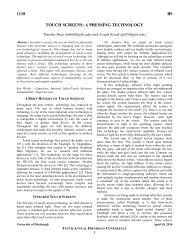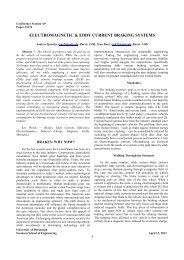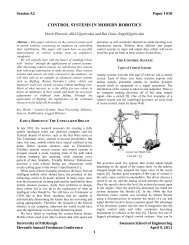THE ECOBOOST ENGINE: COMBINING VARIABLE VALVE TIMING ...
THE ECOBOOST ENGINE: COMBINING VARIABLE VALVE TIMING ...
THE ECOBOOST ENGINE: COMBINING VARIABLE VALVE TIMING ...
Create successful ePaper yourself
Turn your PDF publications into a flip-book with our unique Google optimized e-Paper software.
Conference Section A7<br />
Paper # 3026<br />
<strong>THE</strong> <strong>ECOBOOST</strong> <strong>ENGINE</strong>: <strong>COMBINING</strong> <strong>VARIABLE</strong> <strong>VALVE</strong> <strong>TIMING</strong>,<br />
DIRECT INJECTING, AND TURBOCHARGING TO IMPROVE <strong>ENGINE</strong><br />
EFFICIENCY<br />
Neil Debski (nad61@pitt.edu, Budny 10:00), Seth Kahanov (slk75@pitt.edu, Budny 10:00)<br />
Abstract–With today’s demand for oil, car owners need an<br />
affordable, fuel efficient engine that allows them to make<br />
fewer trips to the gas station. Ford Motor Company, a<br />
pioneer of the first internal combustion engine, recently<br />
unveiled steps towards better engine efficiency by<br />
introducing their EcoBoost engine. The EcoBoost engine<br />
improves the typical standard internal combustion engine,<br />
which is only twenty-five to thirty percent efficient, using<br />
about a quarter of the fuel’s energy to power the car [1].<br />
This paper explains how the EcoBoost engine utilizes the<br />
three components of gasoline direct injection, variable valve<br />
timing, and turbocharging to increase efficiency and boost<br />
fuel economy. These three results benefit the consumer by<br />
improving power, fuel economy, and lowering emissions.<br />
This paper explains how the components of the engine<br />
function together to increase engine efficiency. We will<br />
include detailed and annotated diagrams of the EcoBoost<br />
engine and compare it to competitor internal combustion<br />
engines. EcoBoost engine’s designers analyze how the<br />
engine has made a decrease in size and efficient use of<br />
crucial space in comparison to other engines on the market.<br />
The new technology and transition from a six cylinder to a<br />
four cylinder model has led to a loss of forty-five pounds<br />
from other conventional engines [2]. This paper will also<br />
address how the Ecoboost engine’s cost of a thousand<br />
dollars makes it available to new car buyers. Ninety percent<br />
of Ford vehicles in North America will be available with<br />
EcoBoost by 2013 [3]. The cost availability of the engine<br />
combined with its improved efficiency allows car owners to<br />
makes less trips to the gas pump.<br />
Key Words–Direct Fuel Injection, Fuel Economy, Fuel<br />
Efficiency, Turbo-charging, Variable Valve Timing<br />
<strong>THE</strong> NEED FOR ENVIRONMENTAL<br />
IMPROVEMENT<br />
The Environmental Protection Agency (EPA) has<br />
acknowledged the harmful designs of conventional<br />
automotive engines despite the designers’ beneficial<br />
intentions. According to the EPA’s 1998 studies, “heavy<br />
duty diesel truck engines run cleanly during the agency’s<br />
mandatory performance tests but give off much more<br />
pollution in normal highway use” [4]. This suggests that the<br />
conventional engine designs of the past were most<br />
concerned with what engine would sell the best.<br />
Advertisements for these engines consist of successful<br />
results of regulatory tests, and not successful performance in<br />
everyday use. This disregard for realistic engine<br />
performance displays how companies have not considered<br />
the long term effects that their engines have on the<br />
consumer’s economy and environment. Despite major<br />
automotive companies’ good intentions, “state officials . . .<br />
say the truck engines are fitted with computer chips that<br />
control fuel injection systems, but the systems perform<br />
differently during the EPA’s certification tests than cruising<br />
on highways” [4]. This computerized fuel injection is an<br />
example of poor communication between parts of the engine<br />
that wastes valuable space and does not respond to the<br />
driver’s controls. The immediate effect that this poor design<br />
has is that the engines “routinely exceed the pollution<br />
standards” [4].<br />
However, since these engines have been meeting the<br />
EPA’s standards, automotive companies do not see where<br />
they are at fault. Chief Executive Officer of Cummins<br />
Engine Company, James A. Henderson, has claimed that his<br />
company is “‘cooperating fully and [they] believe [they]<br />
have consistently designed and built engines that comply in<br />
every way with the EPA regulations’” [4]. This thought<br />
process has lead to less efficient engines being sold on the<br />
market. Solutions have been proposed in the past, which<br />
include “increasing the power-volume ratio, extending the<br />
valve overlap, increasing the crank-shaft speed, and<br />
improving the resistance of engine parts to high combustion<br />
temperatures” [5]. These modifications only have improved<br />
the engine performance in extreme conditions, but have also<br />
“contributed to contamination” [5].<br />
The popular mindset of the past towards a solution to<br />
engines’ environmental harms was to “go back to much<br />
larger engines with lower compression ratios and<br />
deliberately design them to run at about one-half present<br />
peak mean effective pressures and camshaft speeds” [5].<br />
This would have decreased the engine’s harmful emissions,<br />
but this large design would also decrease the performance of<br />
the engine as a whole. Overall, this decrease in performance<br />
would be made in order to only resolve the problem of<br />
emissions. As a result of these realizations of the past,<br />
further research has been done in order to maximize engine<br />
efficiency, fuel economy, and environmental benefits. The<br />
first step in this process was improving the communication<br />
within the engine in order include the commands of the<br />
driver during the driving experience. In addition, the direct<br />
injection of fuel was focused on in order to decrease waste.<br />
University of Pittsburgh, Swanson School of Engineering April 13, 2013<br />
1
Neil Debski<br />
Seth Kahanov<br />
However, before direct fuel application was emphasized,<br />
engine design went through a period of inefficient processes<br />
and performances.<br />
<strong>THE</strong> INEFFICIENT WORLD OF<br />
<strong>ENGINE</strong>S BEFORE <strong>THE</strong> <strong>ECOBOOST</strong><br />
Before the technology of the EcoBoost engine was<br />
introduced to the automotive market by Ford, engine<br />
efficiency always compromised either the fuel economy or<br />
fuel efficiency of the engine. The internal combustion of<br />
conventional engines consisted of a less controlled fuel<br />
application to the engine. This resulted in a greater demand<br />
of fuel for the engine since most of the fuel was being<br />
wasted and not applied to crucial parts of the engine. Every<br />
engine design is based off of a translation of the standard<br />
Otto cycle, as seen in Figure 1.<br />
FIGURE 1<br />
Process of the Otto Cycle [6]<br />
The Otto cycle begins after the engine has taken in both<br />
fuel and air and is then adiabatically compressed (without<br />
any heat gain or loss [7] [8]. After this compression, the<br />
temperature and pressure are increased at a constant volume<br />
[8]. The piston with which the compression was applied is<br />
then quickly removed from the resources, which causes<br />
adiabatic expansion. At this point, the exhaust valve within<br />
the engine is opened, which reduces the pressure of the<br />
system back to atmospheric pressure [8]. The piston then<br />
eliminates the exhaust gasses in the system in order for the<br />
Otto cycle to complete and begin again [8]. Steps within this<br />
cycle have become very harmful when dealt with in an<br />
unbalanced manner. When the compression of the air and<br />
fuel is not done within a precise area, a large amount of fuel<br />
is spread out within the engine and not compressed with the<br />
air. This fuel is eventually not included in the engine’s<br />
usable energy and is then swept out of the engine in a later<br />
step of the Otto cycle with other exhaust gasses. What was<br />
once fuel with the potential to better the function of a car is<br />
now a harmful pollutant that only serves to worsen the<br />
environment in which it is released. This unbalance of<br />
concerns regarding fuel injection and fuel application has<br />
been a downfall of several engines of the past, including the<br />
majority of conventional four-stroke engines.<br />
A major disadvantage in standard four-stroke cylinders<br />
has been “the inability to over-rev [perform despite demands<br />
from the driver that exceed the engine’s abilities]. A low<br />
cost poppet valve train typically [lost] control around 12000<br />
rpm or less” [9]. This results in drivers not being able to<br />
control the type of engine performance they need for<br />
different types of travel they could need at any time. Another<br />
drawback from previous two-stroke and four-stroke engines<br />
is that they were “unsuitable for heavy fuel operation due to<br />
difficulties in starting, low power, detonation sensitivity and<br />
carbonization” [9]. These flaws in engine efficiency have led<br />
to high levels of fuel waste. This waste of gasoline makes<br />
the driving experience increasingly expensive. Recent<br />
studies have concluded that more emphasis needs to be put<br />
on the fuel injection design. Early improvements to more<br />
precise injection, done in the MinDwell design, the first<br />
engine design which focused on a new, direct fuel injection,<br />
proved that “application of the MinDwell injection strategies<br />
yielded a reduction in emissions, fuel consumption and<br />
combustion noise” [9] This application of injection precision<br />
led to the engine running “extremely well on heavy fuels . . .<br />
which is a unique capability for an Otto cycle spark ignition<br />
engine without resorting to high pressure injection<br />
technology” [9]. Since the Otto cycle leads to flaws when<br />
one step is done inefficiently, the entire cycle becomes more<br />
productive when the first step is handled with more precise<br />
fuel injection. This improvement of the engine’s Otto cycle<br />
allowed the engine to be more beneficial to both the driver<br />
and the environment. This realization was displayed in<br />
Ford’s design of the EcoBoost engine, which Ford chairman<br />
John Fleming referred to as “a key element of Ford Motor<br />
Company’s global blueprint for sustainability” [10].<br />
<strong>THE</strong> NECESSITY OF DIRECT<br />
INJECTION<br />
Direct injection engines are becoming more common in<br />
automobile manufacturing to improve fuel efficiency and<br />
horsepower in engines. Ford Motor Company uses spark<br />
ignited direct injection (SIDI) technology in its EcoBoost<br />
engine. SIDI engines inject gasoline directly into the air in<br />
the cylinder where the resulting mixture is then ignited by a<br />
spark plug [11]. In SIDI, the fuel is injected at a high<br />
pressure of 2,176 psi as it is injected into the combustion<br />
chamber and not the manifold like in port injection. Benefits<br />
of SIDI include lower emissions especially at startup, higher<br />
compression, better fuel economy on turbocharged engines,<br />
and increased horsepower when compared to port injection<br />
in Figure 2. [11].<br />
2
Neil Debski<br />
Seth Kahanov<br />
FIGURE 2<br />
Port Injection vs. Direct Injection [12]<br />
All gasoline engines depend on atomizing the fuel before<br />
combustion. Unfortunately, with carburetors, throttle bodies,<br />
and even port injection, the atomization takes place at a<br />
distance from the combustion chamber. By the time the<br />
atomized fuel and air reach the combustion chamber, some<br />
of the fuel has separated out and collects on intake.<br />
However, when fuel atomizes and the air and fuel mixture<br />
are cooled in the combustion chamber, a higher compression<br />
ratio is produced thus eliminating the problem. Better<br />
atomization contributes to a reduction in pre-ignition and<br />
detonation, which is why the SIDI engine can operate at a<br />
higher compression ratio and consume less fuel [12]. SIDI<br />
allows the engine to run on a leaner mixture (more air, less<br />
fuel) which allows for better fuel economy at part and full<br />
throttle [12]. The fuel delivery in a SIDI engine comprises of<br />
two components. The low side works with a fuel pump at 60<br />
psi to deliver fuel from the tank to the engine compartment.<br />
The high side, which is located by the cylinder head, is<br />
driven by lobes on the camshaft and delivers fuel at 2,176<br />
psi [12]. The high side, high pressure pump utilizes the fuel<br />
rail’s pressure with an engine control module. This allows<br />
more accurate control over fuel metering (the amount of fuel<br />
injected), and injection timing (exactly when the fuel is<br />
introduced into the cylinder).<br />
Engine knocking is the premature fuel combustion that<br />
can result in power loss of the engine. Engine knocking is<br />
compression detonation or pre-ignition of fuel in the power<br />
stroke of the engine. Knock is a function of heat and<br />
pressure. The fix for engine knock until now has been to<br />
reduce the compression ratio of turbocharged engines. The<br />
compression ratio is the ratio between the cylinder's<br />
maximum and minimum volumes, when the piston is at the<br />
bottom of its stroke versus the top [13]. With direct<br />
injection, the spray of fuel during the compression stroke<br />
helps keep the cylinder cooler, reducing the possibility of<br />
knocking [13]. Like the spray from an atomizer bottle one<br />
might use to keep cool in the summer, the fine mist<br />
generated by each solenoid-controlled injector’s six tiny<br />
outlet holes helps to create a well-mixed air-fuel mixture. It<br />
also cools the incoming air, helping to reduce the potential<br />
for engine knock. This allows for higher compression ratios<br />
which can boost fuel efficiency by a few percent. When<br />
coupled with sophisticated electronic control of how much<br />
fuel to add with the turbo, the end result can be up to a 20<br />
percent increase in fuel efficiency [11]. Better atomization<br />
contributes to a reduction in pre-ignition and detonation,<br />
which is why the spark ignition direct injection engine can<br />
operate at a higher compression ratio and consume less fuel.<br />
The EcoBoost engine has both more peak torque and lower<br />
end torque, meaning direct injection produces a remarkable<br />
flat torque curve. The EcoBoost engine produces 90 percent<br />
of its peak torque between 1,550 and 5,500 rpm. About 98<br />
percent of all driving is between 1,000 and 3,000 rpm [14].<br />
<strong>THE</strong> CRUCIAL <strong>TIMING</strong> OF <strong>VARIABLE</strong><br />
<strong>VALVE</strong> ACTIVITY<br />
The next aspect of the EcoBoost engine that is crucial to<br />
its design is its variable valve timing. This section will<br />
explain how the EcoBoost’s use of variable valve timing<br />
makes the engine fuel efficient as it works along with the<br />
direct fuel injection. We will define variable valve timing by<br />
describing how less overlap between intake and exhaust<br />
strokes allows for better efficiency at low and high speeds<br />
alike. Valve overlap is the time when both intake and<br />
exhaust valves are open, giving an opportunity for exhaust<br />
gas flow and intake flow to influence each other. For<br />
maximum efficiency, valve overlap should allow exiting<br />
exhaust gas to draw an intake charge into the cylinder<br />
without intake gas passing straight to the exhaust system<br />
[15]. At high speeds and torque, output is improved due to<br />
the aided intake of fresh charge due to increased valve<br />
timing. At low speed, the effect of valve overlap is to reintroduce<br />
exhaust gasses into the combustion chamber<br />
[15]. This is known as generating internal exhaust gas recirculation<br />
or internal EGR. Exhaust gas recirculation also<br />
reduces hydrocarbon and NOX emissions by the recirculation<br />
of un-burnt exhaust gasses [15]. The retained<br />
exhaust gasses tend to be very rich in un-burnt<br />
hydrocarbons, as they typically come from the end of the<br />
exhaust stroke. This strategy can therefore be quite effective<br />
at reducing emissions. Each of the three implementations of<br />
variable valve timing uses a cam phaser to adjust the<br />
camshaft angular position relative to the crankshaft position,<br />
referred to as camshaft phasing [15]. A camshaft is a rotating<br />
cylindrical shaft used to regulate the injection of vaporized<br />
fuel in an internal combustion engine, as seen in Figure 3.<br />
The crankshaft is located in the engine of a vehicle and<br />
converts the force created by the engine's pistons moving up<br />
and down into a force that moves the wheels in a circular<br />
motion so the car can go forward.<br />
3
Neil Debski<br />
Seth Kahanov<br />
FIGURE 3<br />
Visual of a Camshaft [16]<br />
The phase adjustment results in a change to the pump<br />
work required by the engine to accomplish the gas exchange<br />
process [12]. The majority of current cam phaser<br />
applications use hydraulically-actuated units, powered by<br />
engine oil pressure and managed by a solenoid that controls<br />
the oil pressure supplied to the phaser [15]. Concentric<br />
camshafts allow for two independent variable valve timing<br />
on a single camshaft. Intake and exhaust centerline timings<br />
are controlled to give prime engine performance over the all<br />
operating ranges. A benefit from the twin independent<br />
variable camshaft timing is a reduction in emissions when<br />
the throttle, that controls the flow of fuel to the engine is<br />
partially open [15]. Lower emission, combined with control<br />
of nitrous oxides and hydrocarbons at all engine speeds,<br />
reduces atmospheric pollution. From a physics standpoint,<br />
variable valve timing can also be used to reduce the work<br />
required by the piston to pump the combustion gasses into<br />
and out of the combustion chamber. At any specific speed<br />
and load, increasing the intake of air into the combustion<br />
chamber allows the engine to burn more fuel, thus resulting<br />
in more power being produced. Concentric camshafts allow<br />
for a 5% increase in fuel economy as well as a 10% increase<br />
of mean torque [15]. This is measured in terms of an<br />
engine’s volumetric efficiency (the actual volume induced<br />
divided by the static cylinder volume). Variable camshaft<br />
timing is electronically controlled by hydraulic valves that<br />
direct high pressure engine oil into the camshaft phaser<br />
cavity. Gasoline direct injection engines are combined with<br />
variable valve timing to create a large improvement in part<br />
load economy due to the reduction in pumping losses. This<br />
improvement stems from the homogeneous mixture of air<br />
and fuel at all engine speeds and loads causing a stratified<br />
charge. Stratified processes allow for a smaller dependence<br />
on a throttle in the intake system as small quantities of fuel<br />
can be added to excess air [15]. The final component that<br />
increases the EcoBoost’s benefits will be described in the<br />
next section with turbocharging.<br />
<strong>THE</strong> <strong>ECOBOOST</strong>’S EFFICIENT TURBO-<br />
CHARGING<br />
The final aspect that makes the EcoBoost engine<br />
efficient is its turbocharger. A turbocharger is a compressor<br />
that forces a greater quantity of the fuel and air mixture into<br />
the engine’s intake and pistons. The compressor wheel is<br />
spun by an attached turbine wheel, which utilizes exhaust<br />
coming from the engine. The spinning wheel of the turbine<br />
has fan blades that compress the air that forces its way to the<br />
cylinder intake, as seen in Figure 4. Due to the increased<br />
mass of airborne gasoline in the cylinder, the combustion<br />
forces the piston down at a higher speed increasing torque. A<br />
turbocharger can decrease the engine’s specific fuel<br />
consumption by as much as 14% [17].<br />
FIGURE 4<br />
Processes of a Turbo-charge [17]<br />
The EcoBoost engine uses two Honeywell GT15<br />
turbochargers with water-cooled bearings. These watercooled<br />
and oil-cooled turbos are quite unlike the turbos from<br />
the 1980s that were cooled only by engine oil. The EcoBoost<br />
turbo bearings are water-cooled in the same coolant loop as<br />
the engine to bring turbo temperatures down. A general rule<br />
for turbocharging is to use the smallest turbocharger possible<br />
that provides the desired performance. This is done to<br />
minimize turbo lag. Turbo lag is caused by the short time<br />
lapse between the moment the accelerator is depressed and<br />
the turbocharger response from the exhaust fumes. As stated,<br />
a turbocharger must have exhaust fumes to fill the turbine<br />
housing in order for the turbocharger to spin and perform its<br />
job. This problem is minimized with a small turbocharger<br />
because it takes less exhaust pressure to spin a smaller<br />
turbine. However, at faster speeds, a larger turbocharger is<br />
capable of providing a greater power boost to the engine<br />
[17]. Since turbochargers give engines lower specific fuel<br />
consumption, the engines output more overall power for less<br />
fuel burned. Manufacturers like Ford are looking at benefits<br />
that are not simply related to improving a car's speed. A<br />
turbocharger on a smaller engine can output the same power<br />
as a larger engine for less fuel. Furthermore, because the car<br />
will weigh less with a smaller engine, the smaller<br />
turbocharged engine will have better performance than the<br />
original large engine without a turbocharger [17]. Direct<br />
injection uses a much higher pressure system (up to 3000<br />
PSI vs. 100 PSI for normal fuel injection) and sprays the fuel<br />
into each cylinder during the compression stroke [13]. Direct<br />
injection allows for a better fuel-air mixture inside the<br />
cylinder, but it has some other benefits as well, especially<br />
with turbocharged engines. For instance, if the air and fuel<br />
4
Neil Debski<br />
Seth Kahanov<br />
mixture gets too hot, it can prematurely detonate “knock” in<br />
the cylinder during the compression stroke and before the<br />
spark plugs fire. Preventing this knocking is why additives<br />
like lead (and more recently MTBE) are added to gas<br />
[13]. Forcing additional air into an engine’s combustion<br />
chambers with a turbocharger definitely boosts power. As<br />
stated, in order to avoid harmful detonation, turbocharged<br />
engines needed lower compression ratios, which<br />
compromised efficiency. Direct fuel injection helps solve<br />
this problem by cooling the intake charge to minimize<br />
detonation. Second, if the variable valve timing extends the<br />
time when both the intake and the exhaust valves are open,<br />
the turbocharger can blow fresh air through the cylinder to<br />
completely remove the hot leftover gases from the previous<br />
combustion cycle. Since the injectors squirt fuel only after<br />
the valves close, none of it escapes through the exhaust<br />
valve, improving efficiency and temperature.<br />
This turbocharger maximizes the engine’s performance<br />
when it is working seamlessly with the engine’s direct fuel<br />
injection and variable valve timing. The EcoBoost engine<br />
uses two turbos, one per bank. These fixed vane turbos<br />
operate in parallel, meaning they operate independently of<br />
one another. Smaller turbos enable faster spool-up, allowing<br />
for faster peak torque, and reduction in turbo lag. By being<br />
mounted close to the cylinder heads, the NVH (noise,<br />
vibration, harshness) of the turbo operation is improved<br />
compared to older systems, and reduce under hood heat.<br />
These smaller turbos spin up faster, kick in at lower engine<br />
rpms, operate at higher turbine rpms, and are fully connected<br />
to modern powertrain controllers [14]. A turbocharger<br />
utilizes forced induction in order to allow more power to be<br />
produced for an engine. The turbine wheel is coupled to a<br />
compressor that pressurizes air coming into the engine —<br />
this is called “boost” and allows the engine to breathe in air<br />
as if it were larger in displacement since more air is “forced”<br />
into the intake [14]. Fortunately, internal combustion<br />
engines have an abundant source of energy that normally<br />
goes to waste right out the exhaust pipe. Turbochargers<br />
harness the thermal and kinetic energy in the exhaust gases<br />
to drive turbines and compressors that force more air into the<br />
engine for a big increase in power [14]. The more air an<br />
engine intakes, the more power it generates. Engine coolant<br />
is responsible for about 60 percent of the engine cooling,<br />
while engine oil handles about 40 percent of the cooling<br />
[14]. Ford has a unique twist on this. The EcoBoost engine<br />
delivers a short spray of oil to the underside of each piston.<br />
Squirt jets deliver a 25 psi dose of oil on each piston stroke.<br />
This does two things. On a cold start, this helps to quickly<br />
warm the oil to operating temperatures, which lowers<br />
internal friction and improves fuel economy. Under normal<br />
operating conditions, of course, the oil squirt keeps the<br />
piston temperatures under cooler levels.<br />
ECONOMIC ETHICS<br />
The EcoBoost’s decrease in fuel waste has led to a more<br />
beneficial fuel economy compared to other engine<br />
technologies. The initial problem when facing the fuel<br />
economy of conventional engines was balancing the<br />
necessary decrease in fuel consumption, while still using<br />
enough fuel to increase the performance of the engine. Most<br />
automotive companies have initially been reluctant to<br />
decrease their fuel consumption because it would<br />
“compromise the present performance, reliability, and speed<br />
flexibility” [5]. This problem only lead to a compromise<br />
before the focus of new designs was direct fuel injection.<br />
With this new decrease in fuel waste, Ford did not have to<br />
compromise their engine’s performance since their engine<br />
utilized the majority of its fuel to increase its efficiency. This<br />
is why Ford has improved their fuel economy, because they<br />
provided better performance with less fuel consumption than<br />
the conventional diesel engine.<br />
In comparison to standard diesel engines, the EcoBoost<br />
“achieves 365 horsepower at 5,000 rpm and 420 foot-pounds<br />
of torque at just 2,500 rpm” [3]. This allows the EcoBoost to<br />
continue to perform with high quality at high speeds while<br />
diesel engines “run out of steam at higher engine speeds”<br />
[3]. This improvement in technology has solved a very large<br />
problem that is faced by drivers on a day to day basis. As<br />
peoples’ need for efficient transportation increases, they do<br />
not have the time or money to waste during constant trips to<br />
the gas station. However, this is what happened in the past<br />
with regular diesel technology, when higher speeds led to a<br />
bigger waste of fuel and less efficient performance.<br />
However, with the EcoBoost’s compact design that<br />
minimizes fuel waste, less money is spent on gas since the<br />
fuel is being utilized in the engine instead of released into<br />
the environment. With the EcoBoost’s direct injection<br />
technology, the engine is able to use all of the fuel that is<br />
applied to it to have the entire engine function for a longer<br />
period of time, which results in a better fuel economy. This<br />
efficient fuel economy is due the EcoBoost engine’s use of<br />
“half the cylinders of the outgoing V-8 with about 237<br />
horsepower” [3]. Economic benefits such as these,<br />
“combined with advanced transmissions, electric power<br />
steering, weight reductions and aerodynamic improvements<br />
are a part of Ford Motors Company’s vehicle sustainability<br />
strategy” [18]. This strategy proves to succeed after<br />
evaluating the economic ethics of the EcoBoost, since the<br />
engine’s decrease in fuel waste makes its performance more<br />
sustainable future use.<br />
Of course, this advanced technology does not come<br />
without an advanced price. However, the EcoBoost’s better<br />
fuel economy eventually leads to a manageable cost-benefit<br />
analysis for the consumer. Regarding most conventional<br />
engines without the EcoBoost’s innovative technology, the<br />
“typical cost is $800” without including the later cost of fuel<br />
[19]. The EcoBoost engine is more expensive than these<br />
engines, with a starting price of “$995,” however this<br />
initially steep price is paying for technology that will<br />
decrease amounts of gas consumption [3]. With these high<br />
5
Neil Debski<br />
Seth Kahanov<br />
levels of torque at low levels of consumption, the engine will<br />
perform at higher efficiency by using less fuel. Economic<br />
analysis has proven that “drivers will recover the additional<br />
initial cost of the [EcoBoost] in an estimated 30 months,<br />
which is significantly shorter than the estimated seven years<br />
for diesel engines and 12 years for hybrid engines” [17].<br />
Despite its high initial price, the EcoBoost will allow the<br />
driver to earn back their initial investment in gas savings<br />
quicker than they would with another engine model.<br />
<strong>ECOBOOST</strong> PUT TO <strong>THE</strong> TEST<br />
To prove the EcoBoost engine is a viable option in the<br />
engine market, it has been compared to other competing<br />
engines, and proves to have the highest efficiency. Ford has<br />
not been the only automotive company with the idea to<br />
better their engines fuel economy. The models for “Hyundai<br />
. . . BMW . . . [and] Chrysler’s 2013 Ram 1500 pickup” high<br />
end cars all have added the feature of “eight-speed<br />
transmission” in order to improve the fuel economy of the<br />
car [20]. However these models have only considered the<br />
economic benefit for the customer, and have not touched<br />
upon the environmental impact that the efficiency of the<br />
engine will have. The result of these other companies’<br />
efforts has been that their models with “transmissions with<br />
more gears aren’t as fuel efficient as some of the other<br />
systems [that consider their environmental and economic<br />
impact, such as the EcoBoost] being offered by automakers”<br />
[20]. These competitors for the Ford EcoBoost have not<br />
combined the same technology that Ford has in order to<br />
improve both the environment and economy that their<br />
engine must live in. Only Ford’s combination of direct fuel<br />
injection, variable valve timing, and turbocharging is able to<br />
benefit the engine’s fuel economy and the driver’s<br />
environment. The companies that Ford is now competing<br />
with are the same companies that, upon the realization of<br />
their loophole around the EPA’s approval, were forced to<br />
“disclose any features on their engines that they know would<br />
increase actual pollution” [4]. The fact that these companies<br />
continued to manufacture an engine that they knew would<br />
not decrease emissions compared to their previous models<br />
proves that the Ford EcoBoost engine has been kept up to<br />
date on the necessities of the society in which it functions.<br />
Ford has chosen to grow with its surroundings, instead of<br />
fight them the way that their competitors have.<br />
One of the original Ford models with the EcoBoost<br />
engine, the 2010 Lincoln MKT, was tested against Audi Q7<br />
SUV. The comparison proved that the Lincoln’s “3.5 liter<br />
twin-turbo V6 cranks out 355 horsepower – more than many<br />
larger V8s, including the Audi Q7 SUV” [21]. This proves<br />
that the EcoBoost engine can perform more efficiently than<br />
other engines in a more manageable size. This smaller<br />
engine size demonstrates how the EcoBoost engine does not<br />
waste the space it occupies within a vehicle and optimizes<br />
the amount of work it does in the space it is provided. In the<br />
same test, after speeding from zero to sixty miles per hour<br />
faster than the V8 Audi, “The Lincoln [delivered] roughly<br />
twenty-five percent better mileage than the Audi, at an EPAestimated<br />
16/22 mpg in city and highway” [21]. The<br />
Environmental Protection Agency has approved the<br />
impressive performance of the EcoBoost engine, which was<br />
initially designed to better the environment. This<br />
performance has also proved more cost efficient compared<br />
to other engines, given its better mileage.<br />
Other than its more efficient conventional performance,<br />
the EcoBoost proves to have the best environmental effects<br />
compared to other companies’ efforts to reach the same goal.<br />
Provided General Motors’ “eAssist” technology, Mazda’s<br />
“Skyactiv” approach and BMW’s “Efficient Dynamics”, the<br />
Ford EcoBoost has “delivered the [environmental] benefits .<br />
. . consistently across a broad product line-up . . . and<br />
managed to create a salient sub-brand that showcases the<br />
benefits of the technology” [22]. After the environmental<br />
effects of these top competitors’ efforts to better the<br />
environment were compared, the EcoBoost proved more<br />
beneficial than any other model in the running.<br />
Designs of other engines are made unique to one specific<br />
automobile, which requires automakers to design new<br />
engines for new cars without utilizing the benefits from past<br />
successful designs. However, the EcoBoost engine has<br />
proven to “deliver better fuel economy and performance on a<br />
full range of vehicles, from small cars to large trucks” [19].<br />
The wide range of applicable automobiles for the EcoBoost<br />
engine has demonstrated that the design is much more<br />
sustainable than other engine designs in terms of applying<br />
the engine to any car that needs a better fuel economy or<br />
environmental impact. The versatility of the engines<br />
applications prove that the EcoBoost engine can be sustained<br />
for automobile designs for years to come.<br />
SUSTAINING <strong>ECOBOOST</strong> BENEFITS<br />
FOR <strong>THE</strong> FUTURE<br />
In order to entice drivers to choose the EcoBoost engine,<br />
they must be ensured that the style of the car they enjoy is<br />
still providing the benefits they desire in a vehicle. With gas<br />
prices in the United States averaging four dollars a gallon,<br />
the EcoBoost engine is a step towards a more fuel efficient<br />
engine. Ford Motor Company increases efficiency and fuel<br />
economy while not sacrificing the horsepower of the engine,<br />
proving to be a lucrative benefit to many consumers. Truck<br />
owners especially have taken a fancy to the EcoBoost and its<br />
powerful yet smaller engine. "People are amazed at the<br />
power," the owner of a car dealership in South Carolina<br />
explained. “Several customers traded in diesel-powered<br />
Super Duty pickups--used mainly for transportation instead<br />
of towing--for the F-150 EcoBoost. They are pleased with<br />
the fuel economy and the power.” [23]. Ford’s numbers<br />
show that the 3.5-liter EcoBoost V6 available in the F-150<br />
exceeded 100,000 sales in less than one year on the market.<br />
6
Neil Debski<br />
Seth Kahanov<br />
EcoBoost-equipped F-150s now account for more than 40<br />
percent of F-150 retail sales. [24]. However, the EcoBoost<br />
engine is not only limited to trucks. Standard four door<br />
sedans such as the Ford Focus, Taurus, and Explorer allow<br />
for the fuel saving technology to be available to consumers<br />
of all car preferences for just a small increase in cost. Even<br />
sports cars such as the iconic Ford Mustang will be getting a<br />
green makeover. Ford executives have confirmed the<br />
adoption of EcoBoost engines for the next generation<br />
Mustang in 2015 [25]. Ford has committed to making<br />
EcoBoost available to 90 percent of its nameplates by 2013,<br />
and adding in the Mustang will take that figure closer to 100<br />
percent [25]. Ecoboost owners who drive 15,000 miles per<br />
year will save a little less than $200 annually at the pump<br />
(with gas at $3.23 a gallon) [26]. The cost of an EcoBoost<br />
upgrade option, depending on the vehicle type, ranges from<br />
$900 to $1500. With an average car lasting around 150,000<br />
miles before resale or scrapping, the EcoBoost engine pays<br />
for itself. These statistics show that the EcoBoost is an<br />
ethical step in the right direction as a fuel saving, pollution<br />
reducing, money saving engine that is suitable in price to<br />
most new car buyers. For this reason, the Ford Motor<br />
Company should continue to improve their line of EcoBoost<br />
Engines. In regards to modern car owners, Ford Vice<br />
President of Powertrain Engineering Joe Bakaj explains,<br />
“Many customers would like the fuel efficiency of a modern<br />
diesel or a hybrid, but can’t stretch their budgets to cover the<br />
cost premium. That’s where the EcoBoost fits in. It will<br />
offer a highly fuel-efficient alternative at a lower cost,” [27].<br />
Not only has this engine made the driving experience user<br />
friendly, its initial benefits are sustainable to hold true no<br />
matter how the rest of the vehicle’s design has been<br />
modified .<br />
<strong>ECOBOOST</strong>: AN IRREFUTABLE<br />
OPTION<br />
Drivers have several choices regarding what type of<br />
engine and vehicle to use on a day to day basis. Considering<br />
how often a driver needs to have easy access to a<br />
manageable ride, this choice should be made regarding<br />
impacts that the car will make that will affect them the most.<br />
These effects that engine designs have are on the economy<br />
and environment that the driver is living in. These have<br />
always been concerns of mechanics while designing engines,<br />
but have never been dealt with in such a balanced and<br />
efficient way as the Ford EcoBoost engine. Previous<br />
attempts to better the fuel economy and environment have<br />
involved increasing the size of the engine and lowering the<br />
compression ratio [5]. This would better the environment,<br />
but decrease the performance of the engine overall. The later<br />
realization of why fuel is being wasted was explored in the<br />
MinDwell design, which made the injection site within the<br />
engine more controlled [9]. This decrease in fuel waste<br />
sparked the emphasis on direct fuel injection for all engine<br />
mechanics, and allowed Ford to design the entire EcoBoost<br />
engine around it.<br />
The direct injection involved in the EcoBoost engine uses<br />
spark ignited direct injection technology, which allows the<br />
engine to inject the fuel in the air in the cylinder and then<br />
ignite the mixture with a spark plug [11]. This enables the<br />
engine to use more of the fuel that is applied to it without<br />
having to release it into the atmosphere during the Otto<br />
cycle. The following crucial technology is the EcoBoost’s<br />
unique variable valve timing which reduces emissions by<br />
controlling the fuel flow to the engine even while the throttle<br />
is slightly open [13]. This is essential to benefitting the fuel<br />
economy of the engine, since the driver will not have to pay<br />
for as much gas, if the gas they initially put in their engine is<br />
being used completely to help the function of the engine.<br />
Another important aspect of the EcoBoost engine is its<br />
efficient turbocharging. The EcoBoost’s turbocharging helps<br />
give the engine the boost that it needs to continue through<br />
the Otto cycle, while cooling the system to both ease starting<br />
ignition and prevent harm or damage to the engine [28]. This<br />
cooling and charging allows the engine to perform at high<br />
quality for long periods of time without the need to stop for<br />
more fuel.<br />
Given all of the EcoBoost’s innovative technology, the<br />
choice to commit to the engine’s benefits comes from its<br />
economic and environmental benefits. The EcoBoost’s<br />
optimization of fuel allows the engine to achieve higher<br />
horsepower at lower rpm, which continues to decrease the<br />
constant need for fuel [3]. This high performance with low<br />
levels of fuel decreases the total amount of money the driver<br />
needs to spend on gasoline, making the cost benefit analysis<br />
favor the initial purchase of the engine. There are several<br />
other companies producing what they believe are highly<br />
efficient engines, but their comparison to the EcoBoost<br />
leaves them flawed. Despite other automotive companies<br />
being able to increase the performance efficiency of their<br />
engines, they are not able to better the fuel economy to the<br />
extent that the EcoBoost engine does [20]. The EcoBoost<br />
engine minimizes the space it occupies within the vehicle,<br />
which in turn gives opportunity for precise direct injection of<br />
fuel. This improvement wastes less fuel, solving both<br />
economic and environmental problems at once. Considering<br />
how long society has had these problems, it is odd to think<br />
of why this innovative technology was not released sooner.<br />
REFERENCES<br />
[1] (2012) “Fuel Efficiency Takes Baby Steps in the Auto<br />
Industry.” New York Times. (Newspaper).<br />
http://www.nytimes.com/2012/06/21/business/global/fuelefficiency-takes-baby-steps-in-the-autoindustry.html?pagewanted=all<br />
[2] (2012) “Ford Puts the Pedal to Its EcoBoost Engine-Tech<br />
Brand.” Forbes. (Online Periodical).<br />
7
Neil Debski<br />
Seth Kahanov<br />
http://www.forbes.com/sites/dalebuss/2012/06/03/ford-gunsecoboost-engine-tech-brand-and-it-races-past-sync/3/<br />
[3] B.Wojdyla. (2013). “The Extraordinary EcoBoost.” My<br />
Ford Magazine. (Online Article).<br />
http://www.myfordmag.com/innovation/ecoboosttechnology<br />
[4] J.H. Cuchman Jr. (1998). “Diesel engine pollution<br />
Investigated” New York Times. (Online Article).<br />
http://www.lexisnexis.com/hottopics/lnacademic/?verb=sr&<br />
csi=152787&sr=HLEAD(Diesel+engine+pollution+investig<br />
ated)+and+date+is+February+11%2C+1998<br />
[5] I. Katz. (1968). “Automobile Engines: Pollution and<br />
Power” American Association for the Advancement of<br />
Science. (Online Article).<br />
http://www.jstor.org/stable/1724739<br />
[6] (2006). “The Otto Cycle” RollsPoyce Enthusiasts Club.<br />
(Diagram).<br />
http://www.rrec.org.uk/Cars/How_A_Car_Works.php<br />
[7] S. Hou (2007). “Comparison of performances of air<br />
standard Atkinson and Otto cycles with heat transfer<br />
considerations.” Energy Conservation and Management.<br />
(Online Technical Report).<br />
http://www.sciencedirect.com/science/article/pii/S01968904<br />
0600344X<br />
[8] (2011). “Otto cycle” The Penguin Dictionary of Physics.<br />
(Online<br />
Dictionary).<br />
http://www.credoreference.com/entry/pendphys/otto_cycle<br />
[9] (2012). “Internal Combustion Engines: Performance,<br />
Fuel Economy and Emissions” Woodhead Publishing.<br />
(Online<br />
Book).<br />
http://site.ebrary.com/lib/pitt/docDetail.action?docID=10641<br />
522<br />
[10] N. McDonald (2009). “Small is green for Ford.” The<br />
Mercury. (Online Newspaper).<br />
http://www.enginetechnologyinternational.com/news.php?N<br />
ewsID=18806<br />
[11] (2009). “Improving Internal Combustion with Direct<br />
Injection.” TechConnect. (Online Magazine).<br />
http://www.acdelcotechconnect.com/pdf/imtn_V16I409.pdf<br />
[12] (2012). “Light-Duty Vehicle Emissions.” EPA. (Online<br />
Article).<br />
http://www.epa.gov/otaq/climate/documents/420r12901.pdf<br />
[13] (2012). “The Future Of Fuel Efficiency.” Arstechnica.<br />
(Online Magazine).<br />
http://arstechnica.com/features/2012/10/more-bang-lessbuck-how-car-engines-now-go-further-on-less/3/<br />
[14] (2011) “Police Fleet Manager.” Hendon Publishing.<br />
(Online<br />
Article).<br />
http://www.hendonpub.com/resources/article_archive/results<br />
/details?id=1091<br />
[15] (2012). “Concentric Camshafts – Independent VVT On<br />
A Single Cam.” Mechadyne International. (Online Article).<br />
http://www.mechadyne-int.com/vva-products/concentriccamshafts<br />
[16] A. Cairns. (2012). “A study of mechanical variable<br />
valve operation with gasoline – alcohol fuels in a spark<br />
ignition engine.” Science Direct. (Online Article).<br />
http://www.sciencedirect.com/science/article/pii/S00162361<br />
12008381<br />
[17] (2013). “Turbochargers.” Illumin. (Online Magazine).<br />
http://illumin.usc.edu/printer/146/turbochargers/<br />
[18] (2008). “Ford Motor Company; Lincoln Unveils<br />
Ultimate Touring Vehicle Concept; Premium Utility<br />
Features Elegance, Space Efficiency.” Resource Week.<br />
(Online<br />
Article).<br />
http://www.lexisnexis.com/hottopics/lnacademic/?verb=sr&<br />
csi=338031&sr=HLEAD(Ford+Motor+Company)+and+date<br />
+is+February+11%2C+2008<br />
[19] (2006). “An Analysis of the Cost-Effectiveness of<br />
Reducing Particulate Matter Emissions from Heavy-Duty<br />
Diesel Engines Through Retrofits”. Environmental<br />
Protection Agency. (Online Analysis).<br />
http://www.epa.gov/cleandiesel/documents/420s06002.pdf<br />
[20] I. Katz. (1968). “Automobile Engines: Pollution and<br />
Power” American Association for the Advancement of<br />
Science. (Online Article).<br />
http://www.jstor.org/stable/1724739<br />
[21] (2009). “Ford EcoBoost Engine Does More With Less.”<br />
Popsci. (Online Article).<br />
http://www.popsci.com/cars/article/2009-09/fords-turbocharged-ecoboost-engine<br />
[22] (2012) “Ford Puts the Pedal to Its EcoBoost Engine-<br />
Tech Brand.” Forbes. (Online Periodical).<br />
http://www.forbes.com/sites/dalebuss/2012/06/03/ford-gunsecoboost-engine-tech-brand-and-it-races-past-sync/3/<br />
[23] R. Kranz. (2011). “Ford Says Optional EcoBoost V6<br />
Engine Popular With F-150 Buyers.” Autoweek. (Online<br />
Article).<br />
http://www.autoweek.com/article/20110428/CARNEWS/11<br />
0429869<br />
[24] N. Johnson. (2012). “Local economy sees boost with<br />
arrival of the EcoBoost Ford Transit Van in 2013.”<br />
Examiner. (Online Article).<br />
http://www.examiner.com/article/local-economy-sees-boostwith-arrival-of-the-ecoboost-ford-transit-van-2013<br />
[25] B. Hill. (2012). “Next Genertion Mustang to Adopt<br />
EcoBoost for Efficiency, Ditch Solid Rear Axle.”<br />
DailyTech. (Online Article).<br />
http://www.dailytech.com/Next+Generation+Mustang+to+A<br />
dopt+EcoBoost+for+Efficiency+Ditch+Solid+Rear+Axle+/a<br />
rticle25527.html<br />
[26] J. Lorio (2012). “Driven: 2012 Ford F150 EcoBoost.”<br />
Automobile. (Online Article).<br />
http://www.automobilemag.com/reviews/driven/1201_2012<br />
_ford_f150_ecoboost/viewall.html<br />
[27] L. Vandezande (2013). “2014 Fiesta Getting 1.0L<br />
EcoBoost Engine.” Autoguide. (Online Article).<br />
http://www.autoguide.com/auto-news/2012/11/2014-fordfiesta-getting-1-0l-ecoboost-engine.html<br />
[28] (2010). “The Future of the Internal-Combustion<br />
Engine” Car and Driver. (Online Magazine).<br />
8
Neil Debski<br />
Seth Kahanov<br />
http://www.caranddriver.com/features/the-future-of-theinternal-combustion-engine<br />
ACKNOWLEDGEMENTS<br />
We would like to thank our Chair, Samuel Scalzo, and<br />
our Co-Chair, Brian DeWille, for keeping us on track for our<br />
requirements and deadlines for our Conference Paper, while<br />
keeping us motivated to improve in every step. We are very<br />
grateful for the assistance and guidelines provided by<br />
Professor Beth Newborg for the Conference Paper. We also<br />
could not have been able to improve from earlier portions of<br />
this paper without the strong constructive criticism and face<br />
to face advice from our writing instructor, Dan McMillan.<br />
9


